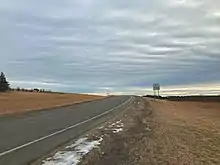Slip lane
A slip lane or slip road is a road at a junction that allows people to change roads without actually entering an intersection.[1] They are primary seen at the junction of two busy roads, as an entrance to a busy highway such as a dual carriageway and are the only means to join a motorway.
Motorways

Slip roads are the only way to join and leave motorways. However slip roads may also be seen on some dual carriageways and even single carriageways with heavy traffic throughput, or at junctions where there may be a high risk for a collision. They are generally long enough to allow a car to accelerate and join the main carriageway at the speed of traffic, reducing congestion. Furthermore it is also safer as the speed difference between vehicles isn’t that much, which helps prevent rear-end collisions.[2] However, in some cases especially on urban motorways, the slip road may continue on the motorway as another traffic lane.
Intersections

Some intersections especially controlled by lights offer a slip lane that allows cars to bypass the lights when turning. This helps ease congestion and improves journey times as people turning don’t have to stop at the light and can continue at the same speed.[3] There are two types of slip lanes at intersections: slips lanes that end and require traffic to merge in order to join the main road and slip roads that continue onto the main road as another traffic lane. However, despite slip lanes being very dangerous to pedestrians, it might actually be safer in some cases to build a slip lane to prevent vehicle-vehicle crashes.[4]
Acceleration/Deceleration Lanes
Some short slip lanes at junctions may continue onto the main road for a short distance to allow drivers to accelerate and safely join the main road. Likewise, some slip lanes may start extra early to allow drivers to decelerate. These lanes, named Deceleration lanes, are mostly seen on motorways were the slip road is extremely short or on fast roads[5]
Slip Lane Rules
Before entering a slip road, drivers must look to ensure that their blind spots are clear of other motorists, cyclists, and pedestrians. Than drivers must give way to any pedestrians crossing the slip road road. Before joining the main road from a slip road, drivers must give way to all other traffic even when that traffic is faced with a give-way or other traffic controls.[6]
Risks
When poorly designed, slip lanes can be a dangerous design element. For reasons of urban design and pedestrian amenity, many road controlling authorities actively remove them in urban and suburban settings.[7][8] Slip lanes may need to be removed if considerations such as pedestrian safety grow to a point where they over-ride the desire to facilitate free passage for cars.[9][10]
To minimise risks of collision, slip lanes can be shaped to enter the traffic flow at a higher angle than the 45 degrees shown in the first sketch. Such lanes are called high entry angle slip lanes.[11]
See also
References
- "Pedestrians crossing slip lanes" (PDF). Main Roads Western Australia. September 2002. Retrieved 8 November 2015.
- https://www.highwaycodeuk.co.uk/joining-the-motorway.html
- https://www.strongtowns.org/journal/2019/11/5/slip-lanes-would-never-exist-if-we-prioritized-safety-over-speed
- https://www.lrrb.org/pdf/200825TS.pdf
- https://policy.tti.tamu.edu/strategy/acceleration-deceleration-lanes/
- http://www.cota-act.org.au/Livedrive/road_rules.html
- "Well Designed Right–Turn Slip Lanes". Federal Highway Administration.
- "Cities Are Replacing Dangerous Slip Lanes With Space for People". Streetsblog. July 2018. Retrieved 4 June 2019.
- "City Road Draft Master Plan" (PDF). Melbourne City Council. July 2015. Retrieved 8 November 2015.
- "Slip Lanes be gone". Matt L. 2 October 2015. Retrieved 8 November 2015.
- "Guidelines for the signing and layout of slip lanes" (PDF). NZ Transport Agency. November 1993. Retrieved 9 May 2017.
